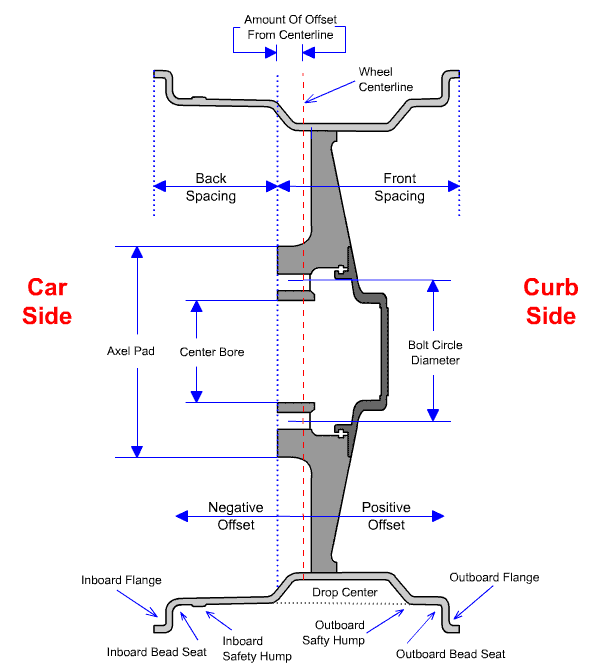Understanding Wheel & Tire Sizes
The simplest way to buy new tires or wheels that fit your car is to look up the current ones and buy ones the exact same size. If you don't want to do that for whatever reason, you found a deal on craigslist on similar sized ones, for example, or you want to up-size your wheels for looks, it starts to get more complicated. I'll start by explaining the different important dimensions on wheels, and then move to tires.
Wheels:
Wheels have five important measurements:
Wheels:
Wheels have five important measurements:
 |
| Image cortesy of sizeitup.com |
- Diameter. This is the one you're probably most familiar with. It is measured in inches and is usually somewhere between 14" and 19".
- Width. Pretty self explanatory. This is also measured in inches.
- Bolt Pattern. This is measured by the number of lugs and the diameter on which they are drilled. It can be measured in either inches or millimeters. This is both important and difficult to measure. The easiest way, if possible, is to find out what car the wheels came from and look up the lug spacing for that model.
- Offset. This is the distance from the centerline of the wheel to the hub-mounting surface and is measured in millimeters. This is pretty important because too small an offset can cause the inside of the wheel to rub against the suspension. Too large an offset is less dangerous, but if too extreme it could cause the tires to protrude from the side of the car.
- Centerbore. This is the diameter of the hole in the center of the wheel. This should match the hub size of your car. If the centerbore is too large, it is possible to use hub-ring to center the wheel.
All these dimensions should be specified on any wheels for sale. If they aren't, make sure to ask before wasting time going to look at them. When a wheel's dimensions are called out they will be written as Width x Diameter ET Offset Bolt Pattern. For example, 7x17ET45 5x114.3. These wheels would 7" wide, 17" diamter with a 45mm positive offset. They would have five lugs on a 114.3mm diameter.
Tires:
Tires have many important charactoristics, but only three relate to size:
1. Section width. This is measured in millemeters and is taken from sidewall to sidewall. This will not be the same as the rim width, but there are several online calculators determine what width tires will work on give rim width.
2. Aspect Ratio. This refers to the sidewall height and is measured as a percentage of the section width. Ideally if you upsize a wheel, you will get a smaller aspect ratio so the overall tire diameter remains constant, avoid inacurate speedometer/odometer readings.
3. Diameter. Refers to the inside diameter and must match the wheel diameter.
So, as an example, a 205/65 R16 tire has a track width of 205mm, a height of 65% of 205mm, and fits a 16" rim.
References:



Comments
Post a Comment